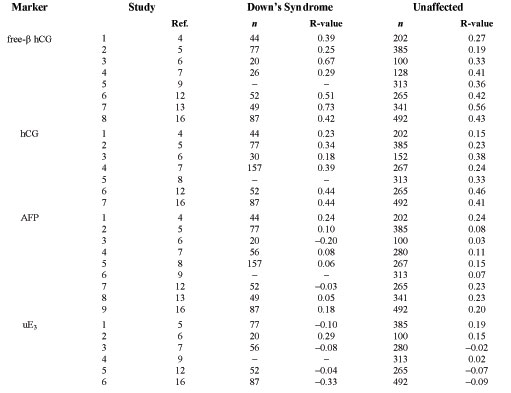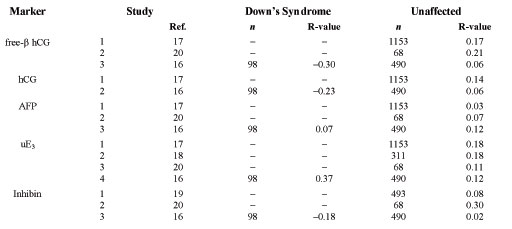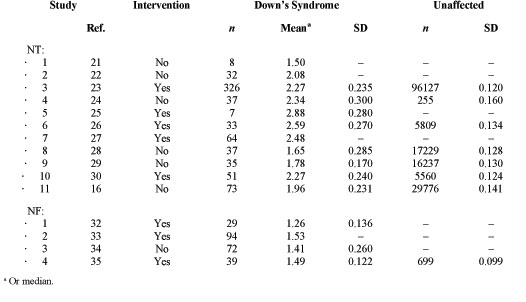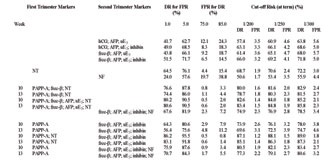


UPDATED MODELING PARAMETERS FOR
DOWN’S SYNDROME SCREENING
Cuckle HS*
*Corresponding Author: Professor Howard S. Cuckle, Reproductive Epidemiology, University of Leeds, 3 Gemini Park, Sheepscar Way, Leeds LS7 3JB, North Yorkshire, UK; Tel.: +44-113-284-9230; Fax: +44-113-262-1658; E-mail: h.s.cuckle@leeds.ac.uk
page: 101
|
|
DISCUSSION
The additional parameters derived here are of use to screening centers that test serum inhibin in the second trimester, ultrasound NT or NF, and serum PAPP-A together with second trimester serum markers. Statistical modeling is essential for DS screening as it forms part of the software used to estimate an individual’s risk. For this purpose meta-analysis provides the most reliable modeling parameters and the most accurate risks are estimated when there is tailoring of variances and covariances to the local population. Another use of modeling is to predict the performance of competing policy options. Again the most robust estimates of performance use meta-analysis derived parameters and appropriate tailoring needs to be carried out depending on whether the policy decision is national, regional or local.
Parameter estimation is an ongoing process. Some of the values derived here should be regarded as provisional until the literature expands. There is very little NF data, expressed in MoMs, and sparse information on the correlation between first trimester PAPP-A and second trimester serum markers. Moreover, more data is needed to calculate covariances for inhibin and PAPP-A so that better tailoring can be carried out.
Since multi-marker serum screening for DS was first introduced there has been a steady increase in the detection rate, in relatively small increments, as new markers have been added. The incorporation of ultrasound markers has continued and accelerated the process.
Table 2. Second trimester inhibin: R-values (log10 MoM) for correlation with other second trimester markers.

Table 3. First trimester PAPP-A: R-values (log10 MoM) for correlation with second trimester markers.

Table 4. First trimester nuchal translucency (NT) and second trimester nuchal fold (NF): means (MoM) and standard deviations (SD) (log10 MoM).

Table 5. Model predicted screening performance for different marker combinations

|
|
|
|



 |
Number 27
VOL. 27 (2), 2024 |
Number 27
VOL. 27 (1), 2024 |
Number 26
Number 26 VOL. 26(2), 2023 All in one |
Number 26
VOL. 26(2), 2023 |
Number 26
VOL. 26, 2023 Supplement |
Number 26
VOL. 26(1), 2023 |
Number 25
VOL. 25(2), 2022 |
Number 25
VOL. 25 (1), 2022 |
Number 24
VOL. 24(2), 2021 |
Number 24
VOL. 24(1), 2021 |
Number 23
VOL. 23(2), 2020 |
Number 22
VOL. 22(2), 2019 |
Number 22
VOL. 22(1), 2019 |
Number 22
VOL. 22, 2019 Supplement |
Number 21
VOL. 21(2), 2018 |
Number 21
VOL. 21 (1), 2018 |
Number 21
VOL. 21, 2018 Supplement |
Number 20
VOL. 20 (2), 2017 |
Number 20
VOL. 20 (1), 2017 |
Number 19
VOL. 19 (2), 2016 |
Number 19
VOL. 19 (1), 2016 |
Number 18
VOL. 18 (2), 2015 |
Number 18
VOL. 18 (1), 2015 |
Number 17
VOL. 17 (2), 2014 |
Number 17
VOL. 17 (1), 2014 |
Number 16
VOL. 16 (2), 2013 |
Number 16
VOL. 16 (1), 2013 |
Number 15
VOL. 15 (2), 2012 |
Number 15
VOL. 15, 2012 Supplement |
Number 15
Vol. 15 (1), 2012 |
Number 14
14 - Vol. 14 (2), 2011 |
Number 14
The 9th Balkan Congress of Medical Genetics |
Number 14
14 - Vol. 14 (1), 2011 |
Number 13
Vol. 13 (2), 2010 |
Number 13
Vol.13 (1), 2010 |
Number 12
Vol.12 (2), 2009 |
Number 12
Vol.12 (1), 2009 |
Number 11
Vol.11 (2),2008 |
Number 11
Vol.11 (1),2008 |
Number 10
Vol.10 (2), 2007 |
Number 10
10 (1),2007 |
Number 9
1&2, 2006 |
Number 9
3&4, 2006 |
Number 8
1&2, 2005 |
Number 8
3&4, 2004 |
Number 7
1&2, 2004 |
Number 6
3&4, 2003 |
Number 6
1&2, 2003 |
Number 5
3&4, 2002 |
Number 5
1&2, 2002 |
Number 4
Vol.3 (4), 2000 |
Number 4
Vol.2 (4), 1999 |
Number 4
Vol.1 (4), 1998 |
Number 4
3&4, 2001 |
Number 4
1&2, 2001 |
Number 3
Vol.3 (3), 2000 |
Number 3
Vol.2 (3), 1999 |
Number 3
Vol.1 (3), 1998 |
Number 2
Vol.3(2), 2000 |
Number 2
Vol.1 (2), 1998 |
Number 2
Vol.2 (2), 1999 |
Number 1
Vol.3 (1), 2000 |
Number 1
Vol.2 (1), 1999 |
Number 1
Vol.1 (1), 1998 |
|
|

